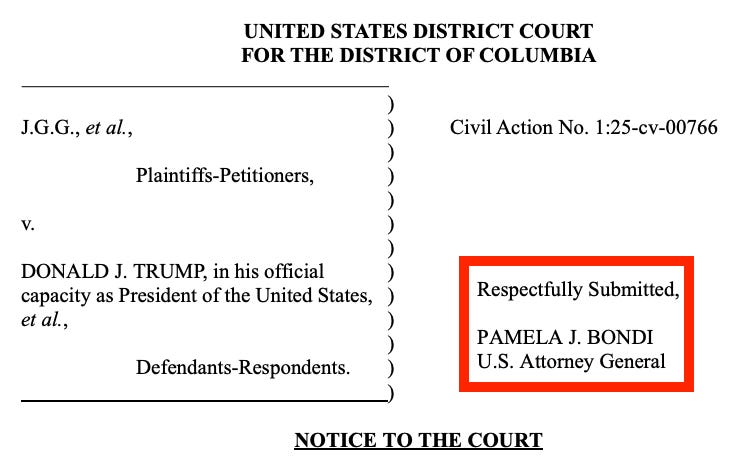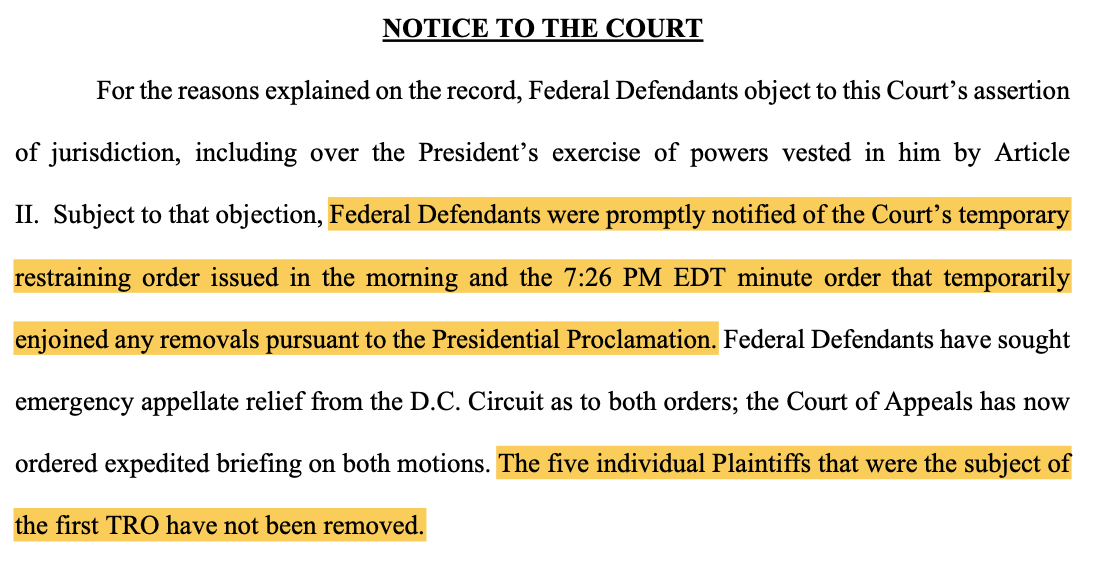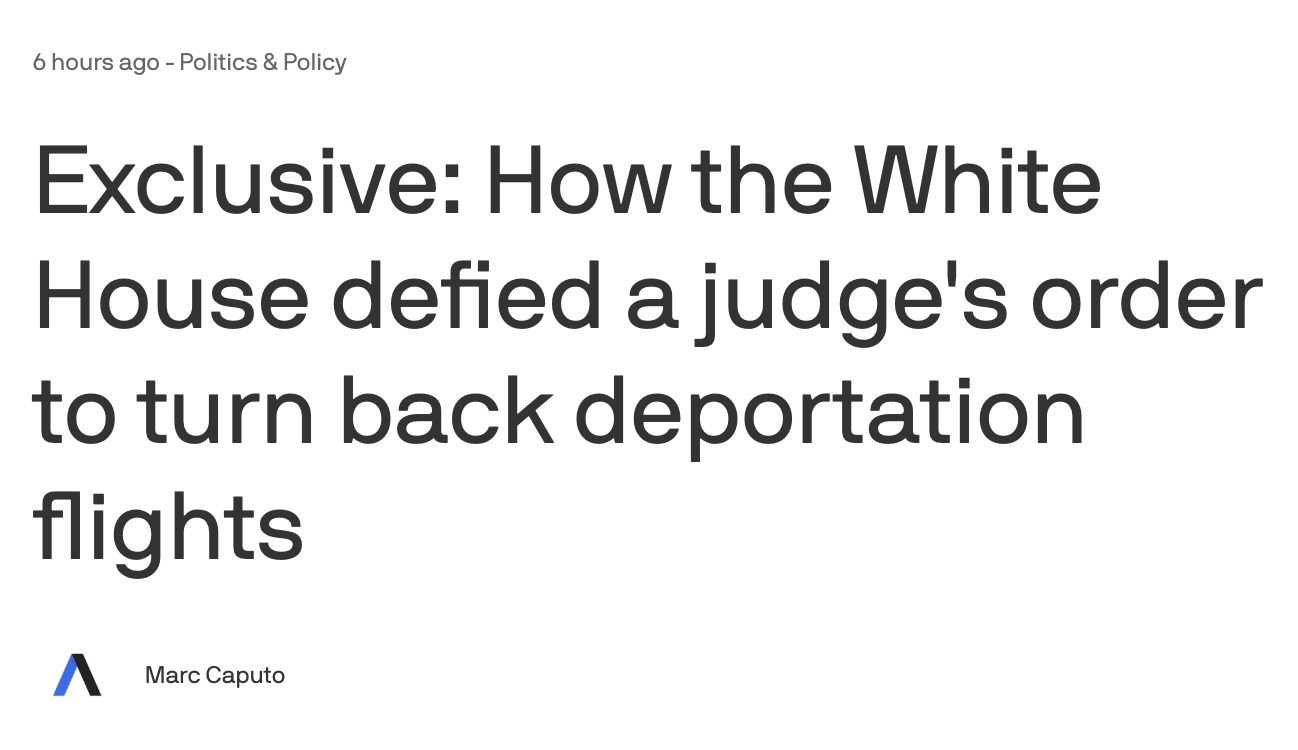Why trying to understand what the Trump admin did in response to the TRO matters
Planes were in the air. They kept going. What did they do, and why? I strongly believe that it matters for our future that we work to understand what is happening.
In the hours after Chief Judge James Boasberg issued his order on Saturday evening to temporarily protect all people being deported subject to President Donald Trump’s Alien Enemies Act proclamation, people began noting that — despite Boasberg’s very clear order — no planes in the air thought to be holding those Venezuelan immigrants affected were turning around.
Then, more planes of a similar nature took off — hours after Boasberg’s order.
On Sunday morning, Secretary of State Marco Rubio thanked and retweeted El Salvador President Nayib Bukele, who in turn showed a video of what he wrote were “the first 238 members of the Venezuelan criminal organization, Tren de Aragua, [who] arrived in our country.” Bukele added, “They were immediately transferred to CECOT, the Terrorism Confinement Center, for a period of one year (renewable).”
The actions caused outrage and confusion, particularly given the timeline and the many unreliable narrators involved.
Planes were in the air. They kept going. What did they do, and why?
Getting the answer is unbelievably — and dangerously — difficult.
The fact is that there are many bad-faith narrators flooding the zone right now, including many within the Trump administration — up to and, of course, including Trump himself. Some of those same people are working to keep information from the public as well. And, while there are many reliable narrators — including, I hope, me — they (definitely including me) don’t have all of the information.
As we have seen over the past two months, the multitude of narrators, the number of unreliable ones, and the intentional effort to keep information from the public makes understanding exactly what is happening at any specific moment difficult.
Maybe that ultimately doesn’t matter, and all that matters is the bottom line that Trump is OK with violating the Constitution and laws, and — particularly in the aftermath of the U.S. Supreme Court’s immunity ruling, at least as Trump himself appears to be viewing (living) it — that, ultimately, will break our constitutional, democratic republic if unchecked.
But — and this is a point that I have been making repeatedly over the past months — I strongly believe that it does matter that we work to understand what is happening. I think this for a few reasons.
It is essential that we record what is happening at every step.
It is essential that all questionable steps are challenged in court.
It is essential that everyone in the structure of government is forced to be accountable for their role in supporting or allowing — or in seeking to stop — illegal and unconstitutional actions.
These steps are not sufficient — much more is and will be needed outside of media, the law, and government — but they are necessary.
Why?
It is clear, and has been, that there are actors in the administration — up to and including President Donald Trump and Elon Musk — who do not really care about the courts and want to fight them.
As I wrote on February 11, “[I]t does appear likely that Trump and/or Musk want to challenge — or at least are not opposed to challenging — the courts’ authority to enforce orders.“
What are they saying?
With this TRO and the administration’s actions in response, we are entering a complicated moment. There are legitimate questions this Sunday night, not just about whether the Trump administration did something illegal or unconstitutional — itself an all-to-common lawless reality — but instead whether the administration affirmatively violated a court’s order.
When things happen that appear to be violations of court orders, people are right to speak up and say so. But, the reality is that, when that happens, we then have to look into the specifics, see what lawyers and subject matter experts think, and — yes — see what the answer given by the Trump administration is for the action that is seen as violating the court order.
I waited Sunday to see what the administration would say. What we got was a two-pronged effort that reflects this difficulty I’ve discussed: It’s clear Trump and some around him are eager for a “let them enforce it” moment, and it’s just as clear that others — including at least some at the Justice Department — are trying in spite of that to keep things from going straight into tyranny.
And this is where we get into the topic that everyone loves me talking about: Whether or not the Trump administration is complying with, narrowly interpreting, or violating court orders.
Around the same time that Axios — laundering anonymous, thus unaccountable, White House quotes — was putting forward Marc Caputo’s story that they “defied” the court order, the Justice Department filed a notice that, while raising many questions, was at least on its face claiming compliance with the court’s orders.
First, DOJ issued a notice that appeared to suggest that the administration did not consider Boasberg’s classwide TRO issued from the bench shortly before 6:46 p.m., when I posted the news, to be the effective time of the TRO, instead only noting that they had informed the “Federal Defendants” of the 7:26 p.m. minute order detailing the bench ruling. This, if I understand what they are doing correctly, is just wrong, and the plaintiffs — and Boasberg — should challenge them on it.
Second, DOJ noted that actions “using authorities other than the Proclamation” would continue — as had, at least in part, been discussed at the hearing. The relevant discussion from the hearing is referenced in Boasberg’s order in his parenthetical that the TRO does not cover those “otherwise subject to removal.“ Some clarity is necessary here, but this is almost certainly what the administration will be using to explain the later flights. (Of course, a further problem with this is that we don’t know who has been deported, and certainly don’t know which “authority” was used to justify that deportation.)
Third, DOJ — citing “information from the Department of Homeland Security — noted that some people who the administration had determined were deportable under the AEA order were already “removed from United States territory” before the classwide TRO. This gets into the question of the flights in the air — which Boasberg ordered to be turned around if not yet landed outside of the U.S.
To understand that more fully, we have to turn to the Axios story — which, if nothing else, at least clarified the third question raised in the DOJ notice.
“White House Deputy Chief of Staff Stephen Miller ‘orchestrated’ the process in the West Wing in tandem with Homeland Security Secretary Kristy Noem,” Caputo wrote — with no sourcing for that sentence at all, despite using the “orchestrated” quote. Their argument, Caputo’s anonymous sources said, boils down to: As to planes "over international waters," Boasberg lacked jurisdiction to tell them to turn the planes around because they were “outside of US airspace.”
Of course that’s absurd — as many others also noted Sunday — because the U.S. government was still in control of the planes, and the Justice Department lawyer before Boasberg on Saturday evening had literally argued, albeit unsuccessfully, that there was no irreparable harm here — a factor in deciding whether to grant a TRO — because the challenge could continue even if individuals had been deported.
Back to Caputo. Anonymous sources — when not used to establish facts — can be be very dangerous in a shifting-story moment like this, because no one can be held accountable for the quotes. Caputo’s story shows why that is particularly dangerous right now. This was the headline that went viral:
This was the updated headline:
It’s just a slight difference, but the “update” in Caputo’s story — with an on-the-record quote from White House Press Secretary Karoline Leavitt, shows how confusing that difference is for readers:
It was good that the sloppy anonymous sources led to an on-the-record clarification — and claimed compliance based on the “removed from U.S. territory” argument. (Also: Even if Leavitt’s “no lawful basis” claim were right — which, it’s not — that is irrelevant to the compliance — and contempt — question, as Marc Elias pointed out.)
Why does it matter?
This is complicated, and it is entirely possible that Boasberg ultimately decides Trump administration officials should be held in contempt for knowingly violating his Saturday evening order.
But, many people — including in my mentions and DMs on Sunday — were telling me the rule of law was over based on the past 30 hours.
I get the feeling. I’m living it unceasingly.
But, before we give up the rule of law because Trump wants us to do so, I believe we must continue to fight for it in spite of anything they throw at us. Additionally, and relatedly, I remain steadfast in my belief that it is key to note who is doing what — and how they are explaining their actions.
While lawyers and others can and should argue that the Trump administration’s argument for its behavior over the past 30 hours is a sham — to use U.S. District Judge William Alsup’s term in another case — I do think it’s important to note both DOJ and Leavitt’s effort to present compliance.
I think statements like these are important right now because they serve to reinforce the legitimacy of the rule of law — even if and specifically because we are in a moment where the rule of law is eroding and they are a key force doing so.
Every single moment, statement, or action that slows down the backslide into authoritarianism is a good one, and we should look for and document them.
Closing my tabs
This Sunday, these are the tabs I am closing:
Keep reading with a 7-day free trial
Subscribe to Law Dork to keep reading this post and get 7 days of free access to the full post archives.








